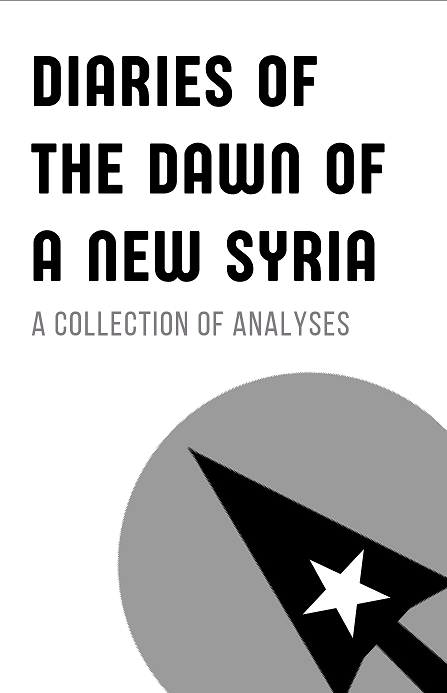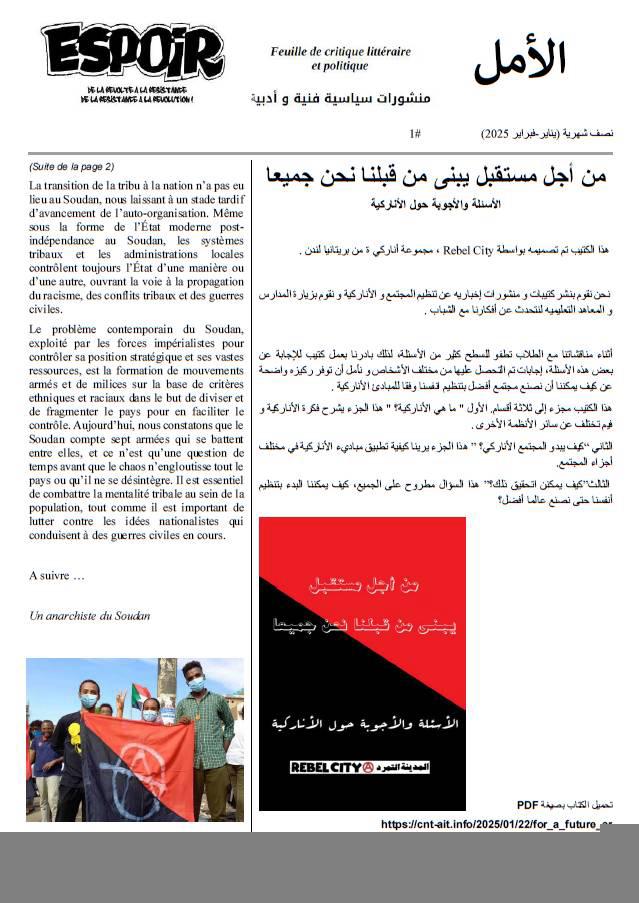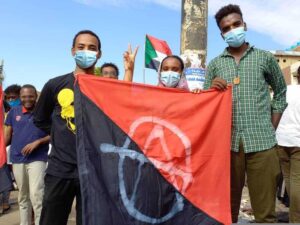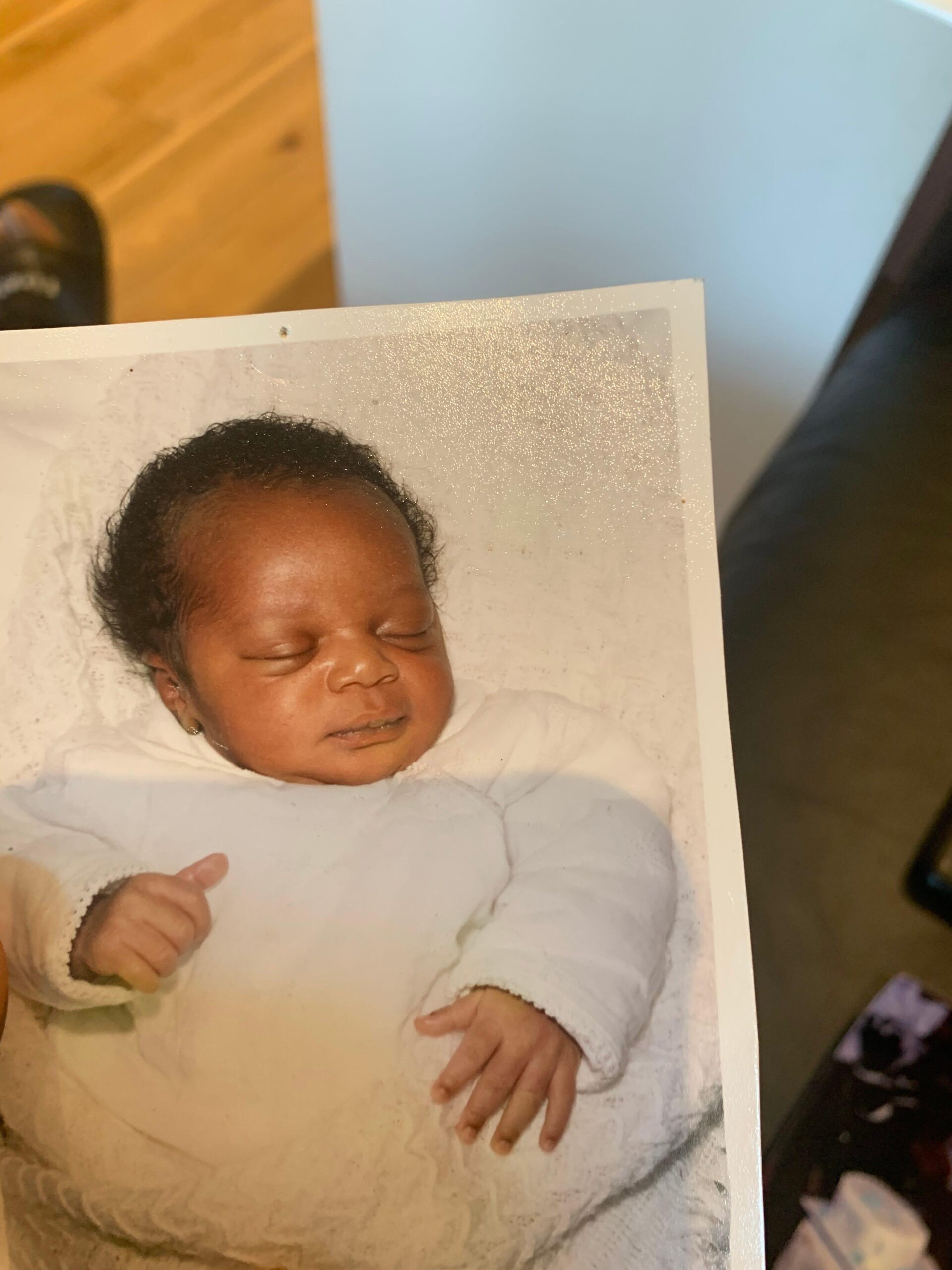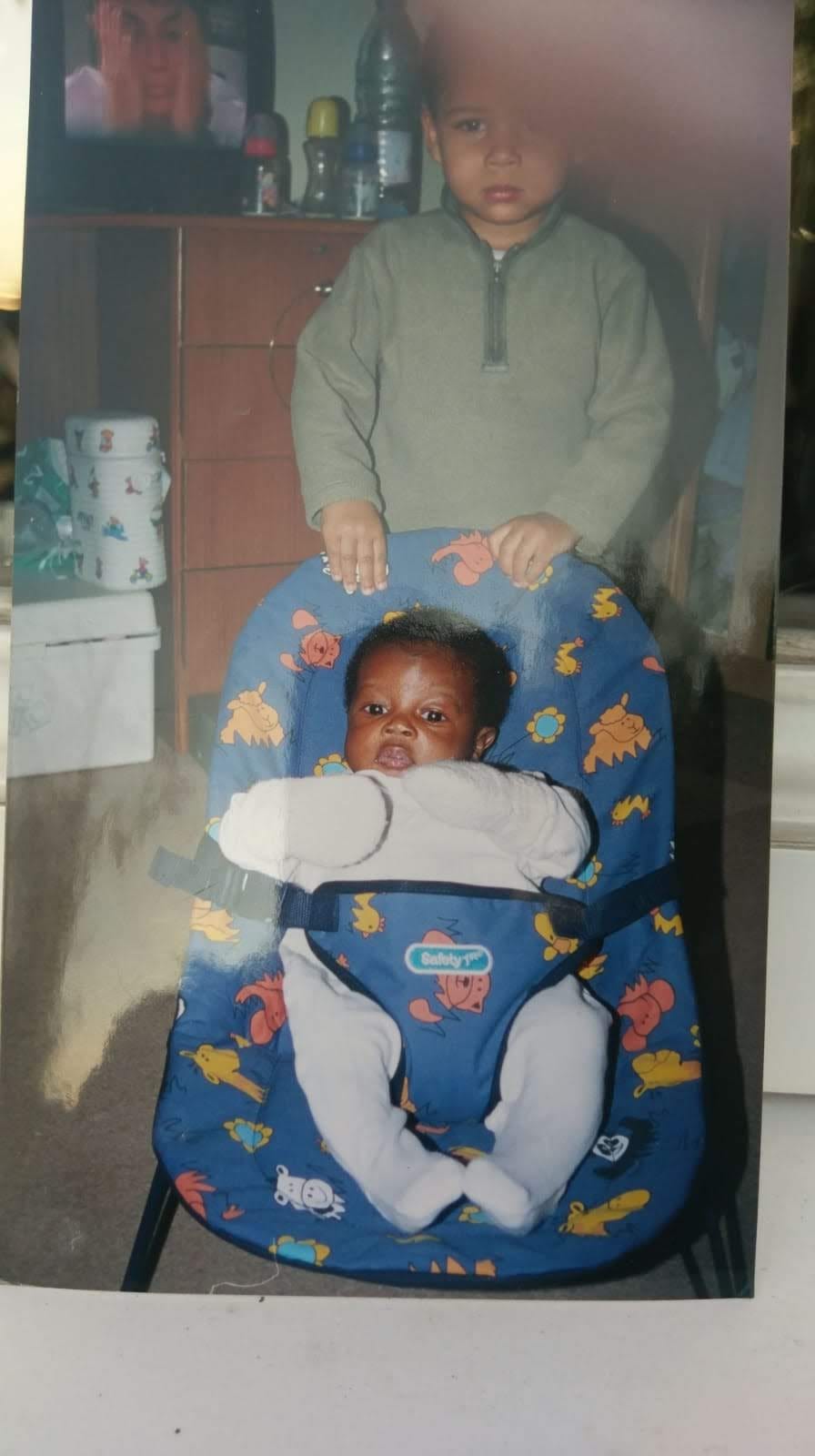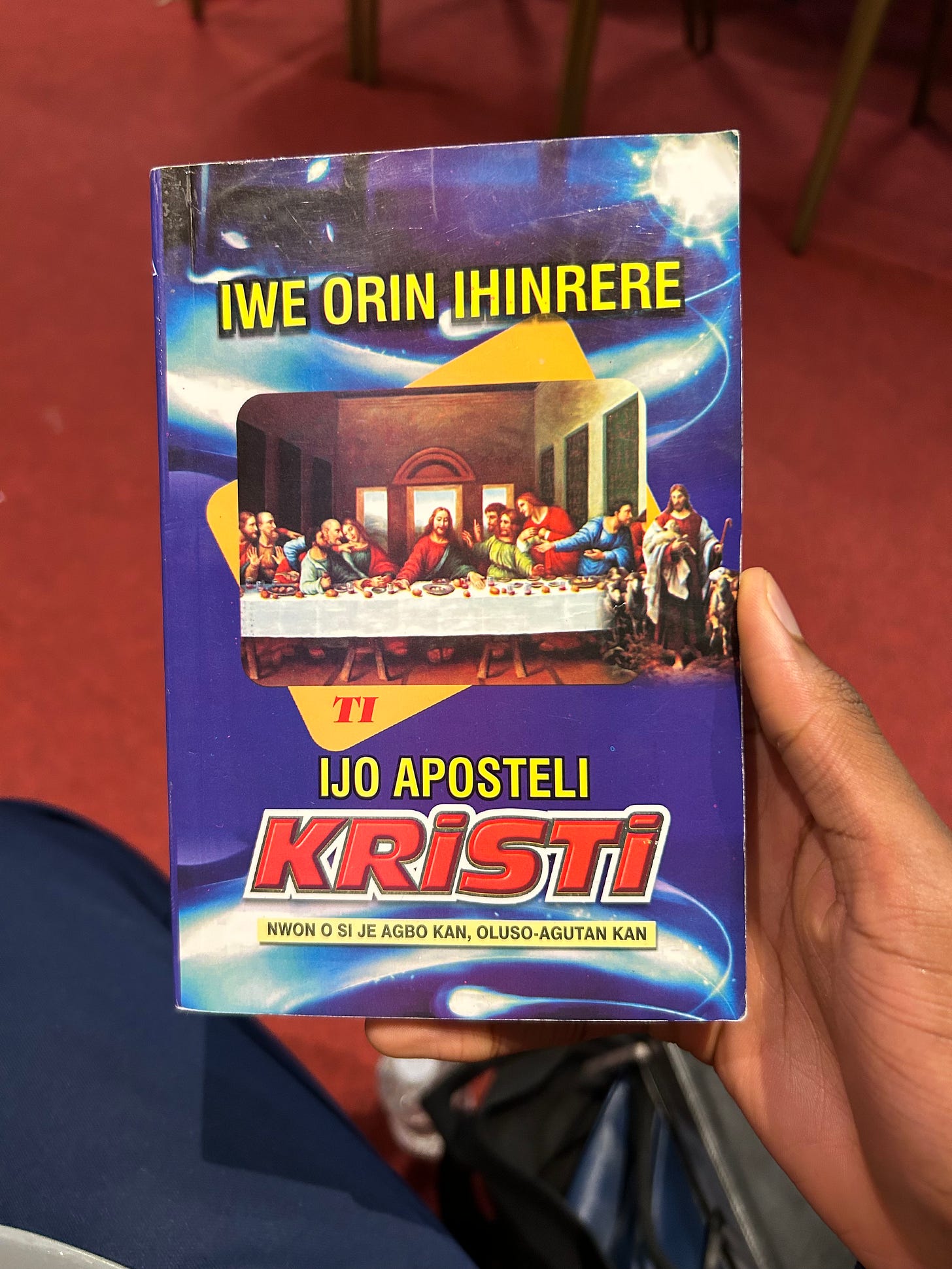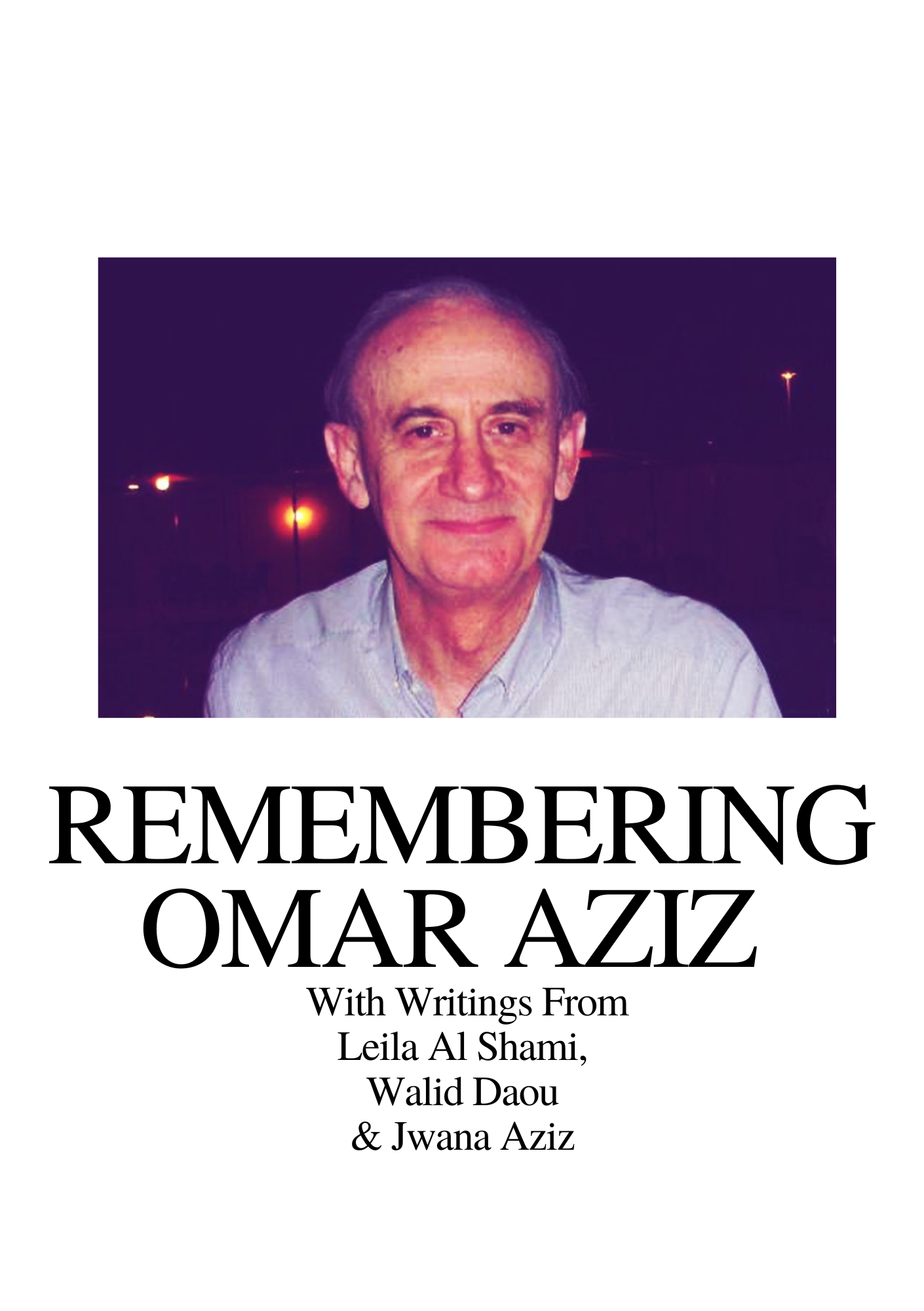
REMEMBERING OMAR AZIZ
Below we have listed three essays that reflect on the life and legacy of Omar Aziz. We are also happy to share this alongside his writing in English and Arabic.
Check his memorial page rememberomaraziz.net and a book being published containing the works of syrian revolutionaries, including Omar.
At the bottom of this page, we have collected some further readings some of you may enjoy.
Leila Al Shami – The life and work of anarchist Omar Aziz, and his impact on self-organization in the Syrian revolution
Omar Aziz (fondly known by friends as Abu Kamel) was born in Damascus. He returned to Syria from exile in Saudi Arabia and the United States in the early days of the Syrian revolution. An intellectual, economist, anarchist, husband and father, at the age of 63, he committed himself to the revolutionary struggle. He worked together with local activists to collect humanitarian aid and distribute it to suburbs of Damascus that were under attack by the regime. Through his writing and activity he promoted local self-governance, horizontal organization, cooperation, solidarity and mutual aid as the means by which people could emancipate themselves from the tyranny of the state. Together with comrades, Aziz founded the first local committee in Barzeh, Damascus.The example spread across Syria and with it some of the most promising and lasting examples of non-hierarchical self organization to have emerged from the countries of the Arab Spring.
In her tribute to Omar Aziz, Budour Hassan says, he “did not wear a Vendetta mask, nor did he form black blocs. He was not obsessed with giving interviews to the press …[Yet] at a time when most anti-imperialists were wailing over the collapse of the Syrian state and the “hijacking” of a revolution they never supported in the first place, Aziz and his comrades were tirelessly striving for unconditional freedom from all forms of despotism and state hegemony.”[1]
Aziz was encouraged by the revolutionary wave gripping the country and believed that “ongoing demonstrations were able to break the dominance of absolute power”.[2] But he saw a lack of synergy between revolutionary activity and people’s daily lives. For Aziz it didn’t make sense to participate in demonstrations demanding the overthrow of the regime whilst still living within strict hierarchical and authoritarian structures imposed by the state. He described such division as Syria being subject to the overlapping of two times “the time of power” which “still manages the life activities”, and “the time of Revolution” belonging to the activists working to overthrow the regime.[3] Aziz believed that for the continuity and victory of the revolution, revolutionary activity needed to permeate all aspects of people’s lives. He advocated for radical changes to social organization and relationships in order to challenge the foundations of a system based on domination and oppression.
Aziz saw positive examples all around him. He was encouraged by the multiple initiatives springing up throughout the country including voluntary provision of emergency medical and legal support, turning houses into field hospitals and arranging food baskets for distribution. He saw in such acts “the spirit of the Syrian people’s resistance to the brutality of the system, the systematic killing and destruction of community”.[4] Omar’s vision was to spread these practices and he believed the way to achieve this was through the establishment of local councils. In the eighth month of the Syrian revolution, when wide-spread protests against the regime were still largely peaceful, Omar Aziz produced a discussion paper on Local Councils in Syria where he set out his vision.
In Aziz’s view the Local Council was the forum by which people drawn from diverse cultures and different social strata could work together to achieve three primary goals; to manage their lives independently of the institutions and organs of the state; to provide the space to enable the collective collaboration of individuals; and activate the social revolution at the local, regional and national level.
In his paper Aziz lists what he thinks the core concerns of the local councils should be:
- the promotion of human and civil solidarity through improving living conditions especially through provision of safe housing to the displaced; providing assistance, both psychological and material to the families of the wounded or detainees; providing medical and food support; ensuring the continuity of educational services; and supporting and coordinating media activities. Aziz notes that such acts should be voluntary and should not be a substitute for family or kin support networks. He believed it would take time for people to feel comfortable outside of the provision of state services and adjust their social behavior to be more cooperative. Aziz believed the council’s role should be kept to a minimum allowing for the development of unique community initiatives.
- the promotion of cooperation including building local community initiatives and actions and promoting innovation and invention which Aziz saw as being stifled by half a century of tyranny. The local council would be the forum through which people could discuss the problems they face in life and their daily conditions. The local council would support collaboration and allow people to devise appropriate solutions to the problems they faced including on issues relating to infrastructure, social harmony and trade, as well as issues that required solutions external to the local community. Aziz also saw a key role as being the defense of territory in rural and urban areas that had been subject to expropriation and acquisition by the state. He rejected the urban expropriation of land and marginalization and displacement of rural communities, which he saw as a method used by the regime to enforce its policy of domination and social exclusion. Aziz believed it necessary to ensure access to land which can satisfy the necessities of life for all and called for a rediscovery of the commons. He was realistic but optimistic. He noted that “it is clear that such acts apply to safe locations or areas quasi- ‘liberated’ from power. But it is possible to assess the situation of each area and determine what can be achieved.” Aziz advocated for horizontal linkages to be made between councils to create linkages and interdependence between different geographic regions.
- the relationship with the Free Syrian Army (FSA) and the interrelation between protection and defence of the community and the continuity of the revolution. Aziz believed that it was essential to coordinate between the popular civil and popular armed resistance. He saw the role of the FSA as to ensure the security and defence of the community particularly during demonstrations, support securing lines of communications between regions, and provide protection for the movement of people and logistical supplies. The role of the council would be to provide food and housing for all members of the FSA and coordinate with the FSA on security for the community and the defence strategy for the region.
- the composition of local councils and organizational structure. Aziz saw a number of challenges facing the formation of multiple local councils. The first was the regime, which repeatedly stormed cities and towns in order to paralyze the movement, isolate the people in enclaves, and prevent cooperation. Aziz argued that to respond to such onslaughts by the state, mechanisms of resistance needed to remain flexible and innovative. Councils would have to scale up or down according to need and adapt to power relations on the ground. He believed this flexibility was essential for the community’s desire for freedom to be realized. He also saw the challenge in encouraging people to practice a way of life and social relationships which were new and unfamiliar. Also service provision needed to be maintained and it was necessary to find a way to get an independent source of power in the face of cuts, as well as supporting the development of economic and social activities. For this reason he believed local council members should include social workers and people with expertise in various social, organizational and technical fields who have both the respect of the people and a potential and desire to work voluntarily. For Aziz the organizational structure of the local council is a process that begins with the minimum required and should evolve depending on the level of the transformation achieved by the revolution, the balance of power within a given area, and relationship with neighboring areas. He encouraged local council’s to share knowledge, learn from the experience of other councils and coordinate regionally.
- the role of the National Council is to give legitimacy to the initiative and gain the acceptance of activists. It should seek funding in order to carry out necessary work and cover expenses which it may not be possible to be cover at the regional level. The National Council would facilitate coordination between regions in order to find common ground and foster closer interdependence.[5]
Omar Aziz’s work has had a huge impact on revolutionary organization in Syria. Whilst the mainstream political opposition failed to achieve anything of note in the past two years, the grassroots opposition movement, in the face of violent repression, has remained dynamic and innovative and has embodied the anarchist spirit. The core of the grassroots opposition is the youth, mainly from the poor and middle-classes, in which women and diverse religious and ethnic groups play active roles (see here and here ). Many of these activists remain non-affiliated to traditional political ideologies but are motivated by concerns for freedom, dignity and basic human rights. Their primary objective has remained the overthrow of the regime, rather than developing grand proposals for a future Syria.
The main form of revolutionary organization has been through the development of the tansiqiyyat; hundreds of local committees established in neighborhoods and towns across the country. Here, revolutionary activists engage in multiple activities, from documenting and reporting on violations carried out by the regime (and increasingly elements of the opposition) to organizing protests and civil disobedience campaigns (such as strikes and refusing to pay utility bills) and collecting and providing aid and humanitarian supplies to areas under bombardment or siege. There is no one model but they often operate as horizontally organized, leaderless groups, made up of all segments of the society. They have been the foundation of the revolutionary movement creating solidarity amongst the people, a sense of community and collective action. See here about Yabroud’s (Damascus suburb) efforts to organize in the absence of the state. Some local committees have elected representatives such as in Kafranbel Idlib, where a committee of elected representatives have made their own constitution (see here). Youth activists from Kafranbel keep the popular protest movement alive and have gained world wide fame for their use of colorful and satirical banners at weekly protests (see here). They also engage in civil activities such as providing psychosocial support for children and forums for adults to discuss issues such as civil disobedience and peaceful resistance.
At the city and district levels revolutionary councils or majlis thawar have been established. They are often the primary civil administrative structure in areas liberated from the state, as well as some areas that remain under state control.[6] These ensure the provision of basic services, coordinate the activities of local committees and coordinate with the popular armed resistance. Undoubtably as state provision of services has disappeared from some areas, and the humanitarian situation has deteriorated, they have played an increasingly vital role. There is no one model for the Local Councils, but they mainly follow some form of representative democratic model. Some have established different administrative departments to take over functions previously held by the state. Some have been more successful and inclusive than others which have struggled to displace the bureaucracy of the old regime or have been plagued by infighting.[7]
Whilst the main basis of activity is very much at the local level, there are a number of different umbrella groups which have emerged to coordinate and network on the regional and national level. These include the Local Coordination Committees (LCC), National Action Committees (NAC), the Federation of the Coordination Committees of the Syrian Revolution (FCC) and the Syrian Revolution General Commission (SRGC). None represent the totality of local committees/councils and they have different organizational structures and differing levels of engagement or non-engagement with the formal political opposition. See here for an interactive map which shows the coordinating committees and councils, as well as the flourishing of many other civil initiatives and campaigns in a country where such activity was previously brutally repressed.
A major threat facing these diverse initiatives has not only been the persecution of activists by the regime, lack of resources, the onslaught of the state’s attack of civilian areas and increasingly deteriorating security and humanitarian conditions. Some local councils have been hijacked by reactionary and counter-revolutionary forces. For example, in Al Raqqa non-local rebel groups with salafi/takfiri leanings took much of the power away from the local council. As they have tried to impose an Islamic vision which is alien to almost everyone, the people of Raqqa have been holding continuous protests against them. In this video here from June 2013 people are demonstrating against arrests of family members by Jabhat Al Nusra. The women are shouting “shame on you! You betrayed us in the name of Islam”. Throughout August 2013 the people of Al Raqqa have been protesting almost daily against the Islamic State of Iraq and al-Sham (ISIS) demanding the release of hundreds of detainees, abductees and missing persons. Likewise in Aleppo revolutionaries launched the ‘enough is enough’ campaign calling for an end to rebel abuses and for accountability. This demonstration from June 2013 was held in front of Sharia Court in Aleppo after the killing of a child for allegedly insulting the prophet Mohammad. The people here are calling for the murderers to be brought to justice saying “”The Sharia Committee has become the Air Force Intelligence!” (the most brutal security branch of Assad regime). In Idlib people have also been protesting against a Sharia Committee which has been established, here they say “we are against the regime, against extremist killing and oppression” and are calling for the return of professional lawyers (independent judiciary) to the court (instead of religious men).
Omar Aziz did not live to see the often seemingly insurmountable challenges that would beset Syria’s revolutionaries, or the successes and failures of experiments in local self-organization. On 20 November 2012, he was arrested from his home by the mukhabarat (much feared intelligence service). Shortly before his arrest he said “We are no less than the Paris Commune workers: they resisted for 70 days and we are still going on for a year and a half.”[8] Aziz was held in an intelligence detention cell of 4 by 4 meters which was shared with 85 other people. This likely contributed to the deterioration of his already weak health. He was later transferred to Adra prison where he died from heart complications in February 2013, a day before his 64th birthday.
Omar Aziz’s name may never be widely known, but he deserves recognition as a leading contemporary figure in the development of anarchist thought and practice. The experiments in grass roots revolutionary organization that he inspired provide insight and lessons in anarchist organizing for future revolutions across the globe.
Notes:
1 Budour Hassan, ‘Omar Aziz: Rest in Power’, 20 February 2013, http://budourhassan.wordpress.com/2013/02/20/omar-aziz/
2 Omar Aziz, ‘A discussion paper on Local Councils,’ (in Arabic) http://www.facebook.com/note.php?note_id=143690742461532
3 Ibid.
4 Ibid.
5 Ibid.
6 For a report on Local Councils see in Gayath Naisse ‘Self organization in the Syrian people’s revolution’: http://www.internationalviewpoint.org/spip.php?article3025
7 Ibid.
8 Via @Darth Nader https://twitter.com/DarthNader/status/304015567231266816
Walid Daou – The Experience of Local Councils in the Syrian Revolution
Source: https://web.archive.org/web/20190308203313/https://www.al-manshour.org/node/7415
Translated by Ghassan Makarem
“We are not less that the workers of the Paris Commune… They lasted 70 days and we are still here since a year and a half.” This is how the organic intellectual Omar Aziz described the revolution in Syria. On 17 February 2013, Aziz was martyred in Adra Central Prison.
This text will review the most prominent local councils, where Aziz played a major role in drafting the founding papers.(1) It will also point out the shortcomings of this type of organization, at least in terms of application.
The increase of the Syrian regime’s crackdown on the revolutionary uprising in Syria, in its peaceful phase, coincided with the desertion of many soldiers and the beginning of skirmishes between the Syrian army and what was to become the Free Syrian Army. The need arose for the creation of organizational structures to manage people’s lives, due to the withdrawal of the regime from its simplest duties, already begun with the implementation of neoliberal “reforms”.
While the Local Coordination Committees (LCCs) had been formed as organizational structures to prepare, call for, and document demonstrations, the idea was that the local councils would be an alternative to the regime and its institutions. According to Omar Aziz, the goal behind forming these councils was “assisting people in running their lives independently from state institutions…; the creation of a space for collective expression, which supports solidarity between individuals and elevates their daily actions into political expression…; providing support and assistance for new arrivals and families of prisoners…; providing a space for discussing livelihood issues…; building horizontal links between local councils…; defending lands in the area in the face of government appropriation to the benefit of the wealthy or military and security officers in the state…” This is in addition to the documentation of violations perpetrated by the regime and its thugs (only), as well as providing relief, coordinating with medical committees, and supporting and coordinating educational activities.
However, due to “the absence of electoral practice in the current situation,” as Omar Aziz says, “the local councils will be formed of workers in the social field and those who enjoy public respect and have expertise in [various] areas.” What is noteworthy here is how to measure “public respect” and when will “the current situation” end? Despite the continuity of the “the current situation,” local council elections were held on the municipal level and a general assembly of local councils, which included members of local councils, was formed on the district level. District councils were also formed and elected an executive office and a president. All these councils were attached to the Ministry of Local Administration, Relief, and Refugee Issues in the provisional government.(2)
In fact, however, the work of these councils was limited to municipal affairs, such as various services, accompanied (competing with?) a constellation of NGOs focusing on the same work. Armed groups remained outside the supervision of local councils. At the same time, the Syrian National Council, the Syrian interim government, and the National Coalition of Syrian Revolutionary and Opposition forces monopolized the “high political rhetoric.”
Thus, the original idea behind the councils became meaningless. Under the hegemony of weapons and conditional funding, the space for council work closed up. Thus, the possibility of building an alternative, democratic authority from below, which could lead the revolution and speak in its name, was diminished. Although these councils were chosen through elections, democracy cannot be limited to the ballot box or a few minutes of electoral practice. It should also mean that women are allowed to participate as candidates and voters(3). It should also mean being aware of racism and sectarianism. It means the participation of all people in running all their affairs, not merely those related to the right to food, health, and education, and away from the control of warlords from all sides. It also means striving to achieve the aspirations of thousands of Syrian men and women who demonstrated, got arrested, were martyred, or displaced. It should ultimately mean striving towards liberty, dignity, and democracy.
Syrian revolutionaries cannot be blamed for the outcome of the revolution. Omar Aziz did not detain himself and did not commit suicide in jail. From the onset, they faced a ruthless enemy, adept at killing at exploiting mercilessly. But this enemy was not alone. It was supported by a wide group of globally and regionally hegemonic countries and Syrian and non-Syrian armed groups. At the same time, Syrians were plagued with a leadership that was nothing but a pawn for the Gulf States and Turkey and begged for western intervention, until this “outside” intervened in favor of the existing regime, either directly or indirectly.
There is much to be learned from the ongoing experience of the local council, both negative and positive. Struggles by people, or humans, as the martyr and comrade Omar Aziz used to call them, are connected and interlinked. People devise their own ways of steadfastness and confrontation. Our destiny is to confront and struggle on various levels and front and to learn from the mistakes of the past and present. It is not merely to honor the dead, and they are many, but to celebrate life.
Published first in arabic on 6 March, 2017
References:
1) The founding papers for the idea of the local councils in Syria written by martyr Omar Aziz in late 2011 were published by Sami al-Kayyal on his Facebook page on 17 February 2013.
2) In March 2014, the National Coalition of Syrian Revolution and Opposition Forces published the constituent by-laws of the local councils in Syrian governorates. On the other hand, the Syrian Nonviolence Movement website published an interactive map of all sorts of peaceful protests in Syria, including the distribution of local councils. The map needs updating, due to changes in the situation between areas recovered by the regime (Daraya and Aleppo, for example) or were taken over by ISIS (such as Raqqa, etc.).
3) Razan Ghazzawi, “Women and the Syrian Revolution,” translated by Walid Daou, Al-Manshour website, 3 April 2014.
Jwana Aziz – We Are Not Pawns, We Are the People Who Rose Against the Regime
Source: https://www.blackrosefed.org/aziz-we-are-not-pawns/
This article by Syrian writer Jwana Aziz reflects on the fall of Bashar al-Assad’s regime. Jwana examines the conditions that precipitated the 2011 uprising, the years of civil war, and the difficulties that now lay ahead for the Syrian people, while also holding open the possibility for a truly liberated future.
Jwana is the daughter of Omar Aziz (Abu Kamel), a Syrian intellectual and anarchist who both theorized and organized local democratic councils in Damascus during the uprising. In 2012 the elder Aziz was arrested by Syrian security forces and in 2013 succumbed to poor conditions in a regime prison.
Introduction
As I sit down to write, I think back to the last time I saw my father. Standing before me, behind iron bars, he was frail and thin, yet he smiled at me. I carry that smile in my memory. My mother and I stood on the opposite side, joined by the rest of the families visiting their loved ones. The divide was meant to be made clear. They, the prisoners, have wronged the state and were to bear the consequences for doing so. We, on the other hand, haven’t, get to walk out and roam free.
Today, I, and Syrians around the world, find myself in the midst of an avalanche of emotions, riding currents of joy, sorrow, hope, and fear, each one pulling me in a different direction. The fall of the Syrian regime was our collective dream, a longing we had aspired for, and as of December 8, 2024, it was realized.
A torn banner depicting Bashar al-Assad.
To effectively understand its descent, it’s important to first understand how he rose to power. When Hafez Al-Assad first seized power in Syria in 1970, the dynasty was designed to reign with an iron fist. During the first three decades, Hafez implemented a system built on capitalist cronyism and corruption supported by heavy surveillance and a militarized police state. This combination proved lethal to any dissent expressed against him and his family.
Consolidating Assets
Assad leveraged his position in power to monopolize control over all critical sectors, ensuring the state, under his rule, dominated nearly every aspect of public and private life. This included telecommunications, real estate, education, healthcare, and even marriage institutions. The 1970s saw a dramatic enlargement of the public sector, making the state the principal employer for Syrians. By 2010, an estimated 1.4 million Syrians were on the government payroll. This strategy blurred the lines between the Assad family and the Syrian state, making them virtually indistinguishable.
Cronyism
Assad’s regime ensured loyalty by cultivating a network of elites bound to the family through economic and social incentives. Positions of power were awarded based on allegiance, often favoring members of Assad’s own sect, the Alawites, along with close allies. This entrenched system of favoritism secured the loyalty of key figures in the military, political, and business sectors, further solidifying Assad’s power. The pervasive nature of their presence was underscored by the countless statues erected in honor of Assad and his cronies, symbolizing their omnipresent dominance over Syria.
Mass Violence, Mass Imprisonment
Perhaps the most potent weapon in Assad’s arsenal was the regime’s willingness to use unrelenting violence against its own people. This strategy reached its most infamous peak with the Hama massacre of 1982. In response to an uprising by the Muslim Brotherhood, the regime unleashed a brutal military campaign. Known as “one of the darkest moments in the modern history of the Arab world,” the regime killed an estimated 10,000 to 40,000 people and destroyed large parts of the city. This event sent a clear message to the rest of us: any challenge to Assad’s rule would be met with overwhelming and indiscriminate force.
The Syrian Civil War, which began in 2011 under Hafez’s son Bashar al-Assad, further escalated this violence to an industrial scale. The regime used carpet bombing, barrel bombs, and chemical attacks to crush opposition-held areas, resulting in the deaths of over half a million people and the displacement of millions. Tens of thousands were arrested, tortured, or disappeared.
Nowhere is the Assad regime’s capacity for violence more evident than in its prisons. Among the most infamous are Tadmor (in Palmyra) and Sednaya, known as “The Human Slaughterhouse.” Sednaya was divided into sections: the “Red Building,” a site of systematic torture and execution, and the “White Building,” which housed prisoners awaiting their fate.
A 2017 report by Amnesty International, based on testimonies from former guards, revealed that after the Syrian Civil War, the White Building was cleared of its existing prisoners to make room for those detained for participating in protests against Bashar al-Assad’s regime. Estimates suggest that about 157,634 Syrians were arrested between March 2011 and August 2024. Among them were 5,274 children and 10,221 women. Beneath the White Building lay an “execution room,” where detainees from the Red Building were transported to be hanged. Between 2011 and 2015 alone, an estimated 13,000 people were hanged there.
A poster reading “Freedom for Omar Aziz” in a demonstration for Palestinian prisoner Samer Issawi on Feb. 6th, 2013, in occupied Jerusalem [Courtesy Budour Hassan].
We have long known about the horrors of these prisons. In August 2013, a military defector codenamed Caesar, who recently revealed himself as Osama Othman, smuggled out 53,275 photographs, documenting the deaths of at least 6,786 detainees. These images provided an unflinching glimpse into the brutality of Assad’s regime. Today, the veil has been lifted further, confirming even starker realities.
Accounts describe unimaginable atrocities of rape, mutilation, defilement of bodies, starvation, and deprivation of basic needs such as food, water, sleep, and medicine. Torture techniques, some inspired by French colonial and German practices, included the German Chair, where victims were bent backward until their spines snapped. The Flying Carpet, a wooden board designed to bring knees and chest together, caused unbearable back pain. The Ladder, where detainees were tied and repeatedly pushed off, broke their backs with every fall. And finally, the Iron Press was used to dispose of bodies en masse.
Knowing these atrocities persisted for years is heart-wrenching. Syrians today are either still searching for answers about their missing loved ones, such as Wafa Moustafa, who is still looking for her father, or mourning the confirmed deaths of their family and friends. This week, Syrians have taken to the streets to grieve the loss of activist Mazen al-Hamada, whose death was confirmed in a military hospital. Mazen, a symbol of resistance and kindness, has an eternal place in our hearts alongside countless others who dedicated their lives for our freedom today: Razan Zaytouneh, Samira Khalil , Ghayath Matar, and all the brave men, women, and children who sacrificed for Syria’s future.
In a recent inquiry, Fadel Abdulghany, the head of the Syrian Network for Human Rights, uncovers evidence suggesting the regime is complicit in incinerating bodies on an industrial scale. “Where are the bodies?” he asks. As of yesterday, around 50 bags of human remains were discovered in barren land near Damascus, one of many suspected mass graves. Echoing Abdulghany’s call, I underscore the urgent need to know where the bodies have been buried, so Syrians can lay their families to rest and begin to etch their future.
Yet amid this darkness, there is joy and determination. Recent videos capture the release of prisoners, among them toddlers, grown men who have lost their memories due to horrific conditions, and women who gave birth in captivity to children fathered by men they don’t know. Despite the haunting realities, today is a day of hope—families are reuniting, and long-separated loved ones are embracing once again. The dismantling of Sednaya Prison marks a momentous day to remember.
Hundreds gather in and outside of Sednaya Prison after the fall of the Assad regime.
We stand in the wake of its downfall, the statues have been toppled, its portraits shattered. the cronies have scattered, the mukhabarat (secret security) dissipated. A family that hoarded wealth and plundered 90% of its people into poverty now finds its house an open one, where regular people walk in and take as they please—sweet irony, or perhaps a fit retribution.
But our celebration will be brief.
What Comes Next?
The vacuum left by the regime is being exploited by nationalist factions like Hayʼat Tahrir al-Sham (HTS), an authoritarian organization with an Islamic fundamentalist ideology, and the Syrian National Army (SNA), a proxy for Turkey. Both HTS and SNA are seen as threats to a democratic Syria. And although the US and Israel did not instigate the offensive that brought an end to the regime, Israel opposes Syria’s liberation due to the potential risks it poses for Israeli control of Palestine and regional stability.
It is imperative, at this moment, we reject all forms of Arab nationalism and colonial entities rooted in ethnic cleansing and settler expansion—whether driven by Israel, the US, Turkey, or others. We must protect and ensure that we do not perpetuate the systematic erasure of ethnic groups including Assyrians, Kurds, Nubians, and Armenians.
It is now up to Syrians to dismantle hierarchal structures and rebuild democracy through “power from below.” My father’s work and that of his comrades demonstrate the ability of working-class self-governance through local councils. They thrived without the state, organizing education, hospitals, and services, all run by the people and rooted in their communities. Syrians are already coming together to restore the infrastructure neglected by the regime. Initiatives to clean and restore public spaces serve as a testament to our resilience and determination.
Unfortunately, the world, once again, stands idle, hesitant to offer the support we deserve. Today, as in the past, discourse seeks to limit Syria’s realities and the possibilities for change. We are framed as passive subjects, slandered with conspiracy theories, and labeled as pawns in a larger geopolitical game.
But we are not pawns. We are the people who rose against a regime we knew would kill us.
As I walked away from the prison on the day I saw my father, I stood on Syrian soil, supposed to be free—yet, I felt anything but. The feeling of being watched and monitored and the suffocating presence of fear was all too familiar. The regime’s grip was everywhere, in the streets, in the shops, on the roads, and in the eyes of the people. Syria, as a land, felt like one vast prison.
If there is one message I could share with the world, it is this: unless you and your community can determine your way of life, you are living within some form of prison. A carceral system that seeks to control and restrict our potential and imagination. If one of the most brutal dictatorships of the 21st century could crumble in a matter of days, then so too can the capitalist system that dominates and exploits our lives. We must be able to dream of that world, the way my father dreamt of Syria.
Jwana Aziz is a Syrian writer whose work has explored feminist social movements and the liberation of political prisoners across the MENA region. Her writing focuses on themes of popular resistance, grassroots movements, and abolition. Inspired by the legacy of her late father, Jwana reflects on Syria’s journey through its darkest moments and the resilience of its people.


